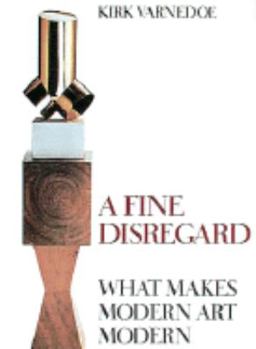Fine Disregard
Select Format
Select Condition 
Book Overview
No Synopsis Available.
Format:Hardcover
Language:English
ISBN:0810931060
ISBN13:9780810931060
Release Date:April 1990
Publisher:Harry N. Abrams
Length:319 Pages
Weight:2.70 lbs.
Dimensions:1.0" x 7.5" x 10.3"
Customer Reviews
5 ratings
Showed me how to enjoy modern art
Published by Thriftbooks.com User , 18 years ago
As one who has never really thought about modern art, and certainly not enjoyed it, this was a transforming book. The tone of the book is welcoming, and the ideas thoughtful. I only picked it up because of the New Yorker article "Last of the Metrozoids," an inspiring and loving description of Varnedoe at the end of his life. His own writing does not disappoint.
A loving meditation on art
Published by Thriftbooks.com User , 21 years ago
Ten stars. This beautifully-written, handsomely-illustrated book is a must-read for all lovers of art, of any period. Not only does Varnedoe illuminate the works of specific artists, traditions and eras, he proposes fresh ways of looking at and thinking about art. Writing about Degas, he says, "This Realism doesn't describe a world, it proposes one." Modern art makes the familiar look strange so that we may come to know it more fully - from a variety of perspectives. Key to Varnedoe's argument is the contribution of the individual artist, whose innovations should not be reduced to a "cultural context" by later historians. My favorite quote in the book comes not from Varnedoe but from the Russian Formalist Viktor Shklovski: "And ... so that stones may be stony, there exists what we call art." A provocative and inspiring read.
Inspiring!
Published by Thriftbooks.com User , 23 years ago
Varndoe's book is the perfect antidote to the complaints of all the reactionary modern art bashers out there who accuse the moderns of lack of talent, pretentiosness or even a nihilistic hatred of reality. *A Fine Disregard* proves the opposite case. The moderns were motivated by the highest artistic impuses, were very talented and (best of all) were free spirits not beholden to static tradition and not afraid to experiment. Yes, some of the experiments failed, but is that not the case in science as well? What is important is that the moderns were imaginative, vigourous and playful in ways that no one had been before them. Rather than acting as passive human cameras, they willfuly exaggerated the colors and shapes of their subject matter in order to express their emotions and tell us which attributes they saw as most important. An artist who saw color as most important might reduce a meadow to a swirling field of unnaturally vivid color. An artist who was fascinated with the shape of things might reduce complex objects to simple geometry for the sake of emphasis. Some modern paintings are not insipred by objects in the everyday world at all, but are an attempt to paint states of mind or reflect on color and shape as ends in themselves. And what is wrong with any of this? Nothing at all. In fact it is a great tribute to human creativity.
A terrific crystal introduction to all art , not just modern
Published by Thriftbooks.com User , 23 years ago
Very fine purgative for all of us confused by the corrective, pedantic style of much art criticism. Varnedoe writes clearly, directly and builds a rich, warm, complex image of modern art. The section on Degas, Hiroshige et al. is wonderful writing. His argument is delivered with a lovely sense of story. An enjoyable,yet provocative read.
modern history of a way of seeing in visual art
Published by Thriftbooks.com User , 24 years ago
Varnedoe pulls together a sychronicity of visual perception between Degas, Hokusai, and other artists including photographers. The evolution of a way of seeing is brilliantly pulled together.




